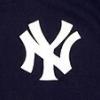Elmer Valo
Elmer William Valo was born in Czechoslovakia but lived the American dream during nearly sixty years in professional baseball. He insisted he was not a “natural athlete,” saying, “Being a baseball player is not a glamorous job, it’s hard work.” In twenty years as a major league player, he reached base as often as Joe DiMaggio.
As teammate Eddie Joost noted, Valo was a complete player who always put out 100 percent and was well liked. Though not a graceful outfielder, he used his sprinter’s speed, superior leaping ability, and sheer determination to make up for any deficiencies. He served as a player representative and goodwill ambassador for the Philadelphia Athletics, and had a lifelong commitment to youth sports as a baseball instructor at clinics and a basketball referee.
Al Simmons reportedly said of him, “There is a guy who should never hit less than .340. He has the timing, the coordination and the strength. If he could only learn to relax a little, he’d be great.
How Valo came to sign with the A’s while he was a junior in high school was reported by John L. Faust in a 1983 article in the Lehighton Times News. According to Faust, Elmer developed blisters on his feet in a touch football game and decided to caddy at a local golf course. Paulsen took off after Elmer, bought him a larger pair of spikes and drove him to the game. After a few more looks, Elmer was signed to an agreement to play after graduation in 1939. No money changed hands. He joined the Federalsburg, Maryland, team of the Class D Eastern Shore League. In his abbreviated season he hit .374 and helped the team win the championship.
It has been said that Valo had one at-bat as an 18-year-old for the Philadelphia A’s in the last game of the 1939 season, which would have made him a four-decade player. Red Smith, a sports writer with the the Philadelphia Record at the time, later wrote that this at-bat was expunged from the official record, supposedly because Valo was not on the active roster and Connie Mack would have incurred a stiff fine. Smith related the story in 1975 as if Valo were jogging his (Smith’s) memory about it. Smith had been the official scorer. When asked about the article years later, Valo politely refused to comment.
Valo rejoined the Athletics after the was in April, 1946. He played sparingly and was batting .083 at the end of the month as the team got off to a horrible 2-10 start. By June he began to hit the ball hard, getting four hits in a 10-4 win over Cleveland to help break a nine-game losing streak. Two days later his game-winning double beat the Indians again, 3-2. The Sporting News reported that he had been working hard on his fielding. He began to gain a reputation as a courageous outfielder. In Baseball’s Pivotal Era, author William Marshall tells how “Elmer robbed Ted Williams of a home run, crashing so hard into the fence he had to be carried off the field.” Valo finished at .307, the first of three consecutive seasons batting .300 or better, but the A’s 49-105 record was the same as 1943.
In 1947 the Athletics were the surprise team of the AL. By mid-June they were only seven games behind the Yankees. Valo missed three weeks after a beaning by Sid Hudson. On September 3, his first day back, he ran up the scoreboard in Shibe Park to make a brilliant catch of what seemed a certain extra-base hit by Mickey Vernon. The play preserved a 3-0, no-hit, no-walk game by Bill McCahan. Ferris Fain committed an error in the first inning of the otherwise perfect game. Valo was also the offensive hero with a two-run double. He batted .300 and the A’s finished over .500 for the first time in 14 years.
The A’s continued to surprise in 1948. The 35 days they spent in first place must have seemed like heaven to the perennial doormats’ fans. Valo hit .305 and provided superb defense. On May 15th before a then-record Saturday crowd at Yankee Stadium of 69,416 he went high up against the right field wall to make two improbable catches and then a third, leaping over the wall in the eighth inning to rob Yogi Berra of a home run and falling back to the field unconscious.
Trade rumors in 1951 had Valo and a pitcher going to the White Sox for slugger Gus Zernial. The A’s got Zernial for two other players, but not Valo. Despite the urgings of new manager Jimmy Dykes, the A’s were in last place on June 15. They then beat the White Sox, who had won 12 straight road games, in the eleventh inning of the opener of a doubleheader. Valo walked with two outs and scored on Zernial’s double to left-center field. Valo would have been out by 15 feet, but he bowled over catcher Gus Niarhos and knocked him unconscious, dislodging the ball. A bench-clearing brawl followed, and Valo and Chicago pitcher Saul Rogovin were ejected for fighting. Valo was injured and was suspended as well.
The Athletics’ move to Kansas City in 1955 was the first of three franchise shifts in Valo’s career. Even after the change of scenery, most sportswriters picked the club for last place. Manager Lou Boudreau announced he would platoon Valo in left field with Gus Zernial. After two years spent mostly on the bench and the disabled list, the 34-year-old Valo rebounded to put up the best numbers of his career: a .364 average and .460 on-base percentage in 338 plate appearances. As a pinch hitter he batted .452 with 14 hits in 31 at bats. He received five votes in the AL Most Valuable Player balloting as the Athletics rose to sixth place.
He moved with the Dodgers from Brooklyn to Los Angeles. As the club fell to seventh place in its new home, Valo hit .248 as a part-timer. After the season, he was assigned to Montreal but asked for and received his release. After 17 years in the majors, Elmer received no interest from major league teams and signed with the Seattle Rainiers as a player-coach in 1959. He became a hustling fan favorite there and big league clubs took notice. Washington Post columnist Shirley Povich wrote, “Who else but Elmer Valo is leading the Pacific Coast League in hitting at .340?” In August, the Cleveland Indians, still in the pennant race, purchased Valo’s contract. He hit .292 in 34 at bats, but the Indians finished third.
In October of 1961 he announced his retirement from baseball. In his twenty year big league career he hit .282, with 58 home runs, and 601 runs batted in.



